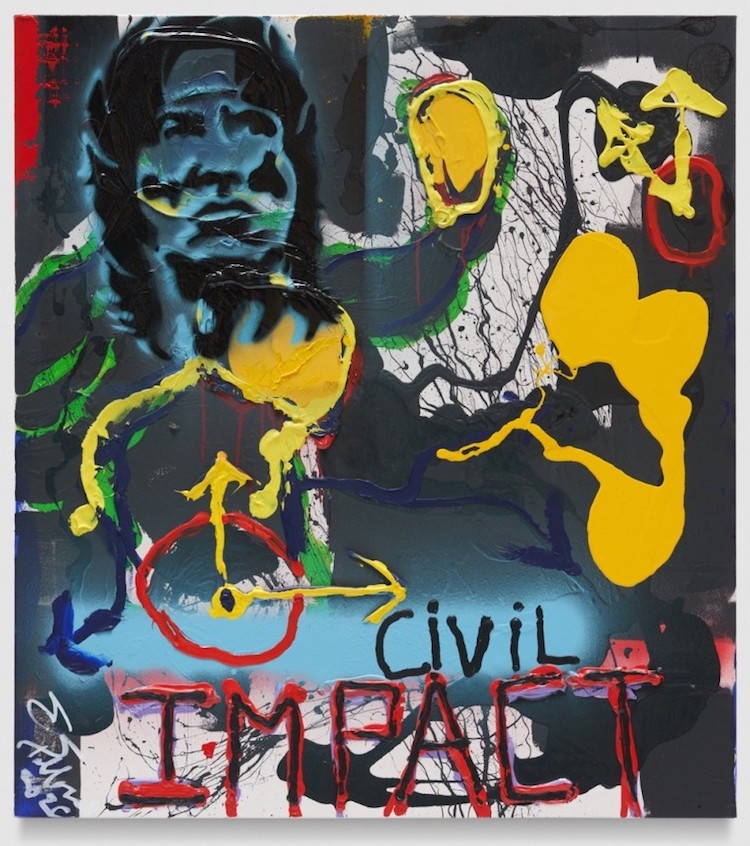Having recently celebrated his 75th birthday, the Hollywood star is bringing his exhibition of artwork to Germany for the first time, which shows another side of the Sylvester Stallone we think we know.
“Hey, kid—you ever think about retiring?”
“No.”
“You think about it.”
This exchange occurs early in the first “Rocky” movie, between the salty, wizened trainer Mickey Goldmill and a big-hearted but disappointing club fighter named Rocky Balboa. To be clear, it is the old man who is encouraging the young man to wrap up his career.
Today, Sylvester Stallone is in his prime and we are happy to report that the prospect of retirement does not seem to excite him at all. Seniority and life experience sound different from “old“. Happy belated 75th birthday, dear Sylvester Stallone!
On the occasion of his birthday, which actually took place last summer, he is showing his first exhibition in Germany – after St Petersburg (2013) and Nice (2015) – in Sauerland, which is probably mostly associated with agriculture, breweries and shooting festivals.
What many don’t know is how it all began: Stallone’s most famous film character “Rocky” was first created as a painting on canvas long before the film script and can be seen as “Finding Rocky” from 1975 in the Osthaus Museum in Hagen (the gateway to the Sauerland). Before Stallone took off as an actor, he painted. For financial reasons, however, he then worked as a writer and began his acting career – the outcome of which many people are probably well aware.
Why Hagen?
In the years before the First World War, Hagen, the grey working-class town with no worldly glamour, was one of the most important centres in Europe of the reform movement against encrusted structures of Wilhelminism and set impulses, the so-called Hagen Impulse. Hagen was, for example, one of the first places in Germany to have Art Nouveau buildings, which later – after the First World War – blossomed in the Weimar and Dessau Bauhaus.
Karl Ernst Osthaus from Hagen acted in his home town as a patron, mediator and organiser of a vision ‘to let beauty again become the ruling power in life’ and invited artists such as Christian Rohlfs, Emil Rudolf Weiß and Milly Steger to Hagen and gave them the opportunity to develop free of economic hardship. Emil Nolde called Osthaus ‘a sign from heaven’. Today, the Hagen Impulse is a fixed term in art history worldwide, yet the relatively short period of Osthaus’ work remained no more than an impulse for the city of Hagen.
We suspect that Sylvester Stallone took up on this impulse, showing his art here quite unexpectedly. For the Hollywood star, it is easy to change roles on the screen; as an action star, he remains sorted. But as a painter?
“Painting is the purest of all arts. And it’s not like film, where 500 people are responsible for the final product. Here it’s one man who has to endure the fame, the ridicule or the criticism. Fear and anxiety push you forward in painting. They push you to the next level. But failure remains for me the best way to learn,” Sly tells his numerous listeners in a calm, sonorous voice.
According to the Osthaus Museum’s announcement, his paintings are on the one hand action-packed and expressive like his films, and on the other hand subtle and multi-layered in their statements. Stallone uses art forms such as surrealism, expressionism and abstraction.
Sylvester Stallone was intensively involved with contemporary art as a collector and as a painter. At the end of the 1980s he was particularly interested in the art of Picasso, Gerhard Richter and Anselm Kiefer. He also dealt with the abstract works of Mark Rothko and developed his own style. In this way, he created numerous expressionistic works, some as alienated self-portraits, others playing with language.
The exhibition is accompanied by a comprehensive bilingual catalogue, with interviews as well as texts by Dr. Tayfun Belgin, director of the Osthaus Museum Hagen, Dr. Evgenia Petrova, scientific director of the Russian Museum, St. Petersburg, and Dr. Jérôme Neutres, the former director of the Réunion des Musées Nationaux-Grand Palais and president of the Musée du Luxembourg.
Osthaus Museum Hagen
Sylvester Stallone
75th birthday retrospective
December 4 – February 20, 2022
Staying awake, alive and active from art – that is the best compliment for artistic competence!
What else is there to do?
The area offers a lot of nature, culture, enjoyment and business.
Six Unesco World Heritage Sites with Cologne Cathedral, Aachen Cathedral, Augustusburg and Falkenlust Castles in Brühl, Zollverein in Essen, Corvey in Höxter and the Lower Germanic Limes (along the Rhine).
Getting there
A total of six airports connect North Rhine-Westphalia with all major domestic destinations in Germany as well as with metropolises all over the world. The two major international airports Düsseldorf Airport and Cologne Bonn Airport as well as the airports with European connections in Dortmund, Münster/Osnabrück, Paderborn/Lippstadt and Weeze/Lower Rhine take you quickly to your destination.
All images courtesy Osthaus Museum Hagen
Lead image Sylvester Stallone in Atelier, Courtesy Galerie Gmurzynska / Artwork: Sylvester Stallone;
Sylvester Stallone: Jo Poe, 1966, Öl auf Leinwand mit Rahmen des Künstlers, 76,2 x 61 cm, Courtesy Galerie Gmurzynska / Artwork: Sylvester Stallone
Sylvester Stallone: Wild Horses, 2018, Courtesy Galerie Gmurzynska / Artwork: Sylvester Stallone
Sylvester Stallone: Civil Impact, 2020, Courtesy Galerie Gmurzynska / Artwork: Sylvester Stallone





Leave a Reply